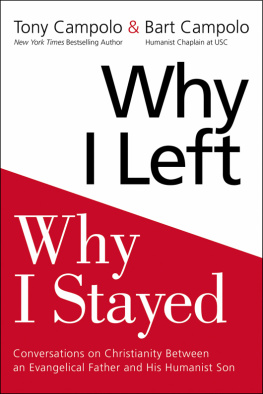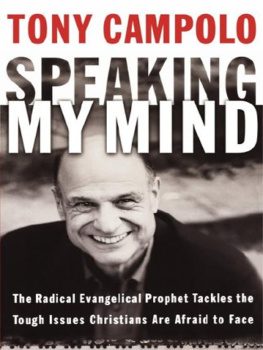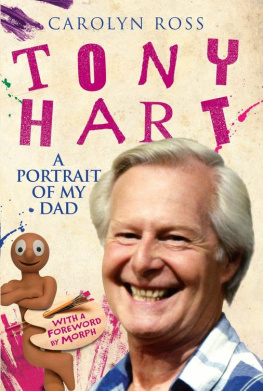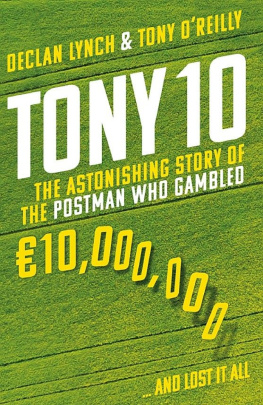Let Me Tell You a Story
Tony Campolo
LET ME TELL YOU A STORY
2000 Tony Campolo
All rights reserved. No portion of this book may be reproduced, stored in a retrieval system, or transmitted in any form or by any meanselectronic, mechanical, photocopy, recording, scanning, or otherexcept for brief quotations in critical reviews or articles, without the prior written permission of the publisher.
Published in Nashville, Tennessee, by Thomas Nelson. Thomas Nelson is a registered trademark of Thomas Nelson, Inc.
Thomas Nelson, Inc., titles may be purchased in bulk for educational, business, fund-raising, or sales promotional use. For information, please e-mail SpecialMarkets@ThomasNelson.com.
Scripture quotations are from The Holy Bible, King James Version.
Library of Congress Cataloging-in-Publication Data
Campolo, Anthony.
Let me tell you a story / by Anthony Campolo
p. cm.
ISBN 978-0-8499-4205-1 (pbk.)
1. Homiletical illustrations. I. Title.
BV422.2 .C34 2000
251.08dc21
00-34985
CIP
Printed in the United States of America
08 09 10 11 12 QW 22 21 20 19 18
Dedicated with hopes and prayers
to
Naomi Ruth Goodheart,
My newest granddaughter,
Whose story is about to be told
Contents
Over the years, I have written twenty-six different books. In them I have told a lot of stories to illustrate the ideas and concepts I was trying to communicate. Im not sure that people remember my concepts and ideas, but Im very aware that my readers remember my stories. Many have utilized them in sermons or teaching situations. I have also collected scores of stories that I have never utilized in sermons or in my writings. I got to thinking that it would be a good idea to put all these stories together in one book. And so I did.
I want you to feel free to use these stories at will. Needless to say, I would like you to provide credit where credit is due, but it would be a source of encouragement to my ministry if I knew that these stories were being used to drive home truth and illuminate the messages of those who seek to communicate the gospel.
Since I am primarily a speaker, rather than a writer, I want to give a bit of advice on how to use stories.
The same story can be utilized to illustrate a host of different truths. As you come across stories in this book, do not think they can only be used to address the subjects indicated by the topic headings under which they fall. With some solid employment of the imagination, you will be able to use many of these stories to highlight points and illustrate truths other than the ones for which I have employed them.
In telling a story, you will have to do a lot of practicing in order to be effective. Often my listeners think I am telling a story for the very first time because I work hard at seeming spontaneous, as ironic as that sounds. Timing is everything in the telling of a story. The pauses, facial expressions, hand gestures, and the speed at which the story is told, all must be carefully rehearsed if the telling is to be effective.
If the meaning of a story is self-evident after making the application, move on. Explaining a story at length can make your communication seem didactic.
One final warning! No story or illustration perfectly or completely reveals the truth it is intended to convey. Please dont use the stories as though they were full explanations of what I believe and what I think. In most instances, these stories convey the best of the truth as I understand it, and in some rare cases they may evidence more. As you read them, ENJOY! I hope they get you to laugh and cry and feel the messages of the gospel with increased passion.
The Bible says that no man liveth to himself, and no man dieth to himself. And so it is with the writing of books. In the writing of this one, special thanks must go to Valerie Hoffman. She spent huge amounts of time typing out the contents of what you read. Unlike any other book I have written, this one was put together almost completely via dictation. Valerie had the unenviable task of listening to my voice droning on for hours from dictation tapes. If you like this book, please stop and give her a special round of applause.
TONY CAMPOLO
Eastern College
St. Davids, Pennsylvania
My mother was a storyteller. She was the very best. She kept the family entertained at dinner, and though she told the same stories over and over again, we never tired of listening to her. That was because they were never exactly the same. The words she used, the descriptions she provided, the detailed exchange of comments between the characters of her stories, seemed better with each telling.
In later life, Mom worked in an old folks home, and the management of the home was glad to have her because of her storytelling. She could keep old men and women entranced. She was able to carry them out of the mundane setting of the home into a never-never land of wide experiences.
I inherited the propensity for storytelling from my mother, and when I preach, I hardly ever make a point without illustrating it in some way. Sometimes people question the veracity of the stories I tell. On one occasion, some people took my son aside, when he was just a little boy, and asked, When your father tells those wonderful stories, are they really true? In a lot of them you are the main character. So, tell us, do things really happen the way he says they do?
My son reflected thoughtfully on the question and answered, Yes, my dad does tell the truth. But, when I hear him tell the stories, I always have the feeling that he remembers big! To such a charge I will plead guilty, because I often sense extraordinary things in ordinary situations. So far as Im concerned, that particular practice is what makes stories really good.
When I went off to study at seminary, my professor of preaching was Dr. Norman Paullin. He was one of the most loved preachers in the Philadelphia area. He, more than any other preacher I knew, was able to tell stories in a way that made the listener feel he or she was right there when the events of the story happened. I remember him saying to us once, My sermons are like the Empire State Building... Theyre just one story on top of another!
Given my mothers propensity for storytelling, and that Norman Paullin was my homiletics professor, it should come as no surprise to my audiences that the substance of what I communicate day in and day out is generally in the form of stories. One of my critics has said that I use illustrations like a drunk uses lamppostsmore to support his instability than to illuminate his path. He may be right in that accusation. Someone else suggested that I use stories instead of theology as a basis for my sermons, but I must tell you that, in the end, my stories do not illustrate my theologythey are my theology. I choose to tell truths about myself, about others, and most of all about God, not with theological statements, but with stories.
Sren Kierkegaard, the Danish philosopher who made existentialist thought seminal to much of Christian theology in the middle part of the twentieth century, would have approved of my approach to communicating truth. He made the point that Jesus preached primarily through storytelling because, according to Kierkegaard, the gospel is not so much heard as it is overheard! By that Kierkegaard meant that the Bible is full of stories about all kinds of people, both good and bad, and as the stories of these people are told, we find ourselves. Perhaps a good example of how that really works comes from Henri Nouwens wonderful sermon on the prodigal son. In that story all of us can identify with the characters as Jesus describes them. Nouwen makes clear that each of us will identify, at one time or another, with each of the storys characters. Each of us can at some time be likened to the prodigal son. We have all wandered away from a fathers goodness and adopted a destructive lifestyle, only to discover the futility of it all, and then wanted to go back and set things right. At some other point, each of us acts like the elder brother of the story, exhibiting a holier-than-thou self-righteousness, and showing a reluctance to forgive and offer restoration to the brother or sister who needs it. And ultimately, each of us will have to someday play the role of the father, who will be challenged to show unconditional love and welcome the sinner home again.














